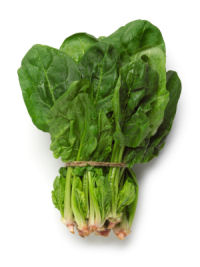Nutrient Density measures the benefits you get from a food compared to the number of calories it contains.  Nutrient-dense foods give you the most nutrients possible for the fewest calories. For example, some energy bars provide 15 percent of your daily folate (a B vitamin found naturally in certain foods- especially leafy greens) requirement for about 200 calories.
Nutrient-dense foods give you the most nutrients possible for the fewest calories. For example, some energy bars provide 15 percent of your daily folate (a B vitamin found naturally in certain foods- especially leafy greens) requirement for about 200 calories.
A cup of raw spinach, on the other hand, packs the same folate punch for only 7 calories.
Foods with high nutrient density provide relatively few calories (with tons of antioxidants, vitamins and minerals) and consequently give you a feeling of fullness with smaller portions. Your body gets a chance to respond and send a signal to your brain and say, “I’m full”, because it is absorbing all those healthy, delicious nutrients. As a result, your nutritional wellness and immunity system improves and as a side benefit, you get to lose excess weight this way naturally.
One way to measure nutrient density is with the ANDI (Aggregate Nutrient Density Index) scale. Developed by Joel Fuhrman, MD, ANDI measures the amount of key nutrients in a food, relative to its calories. Dr. Fuhrman states we “should be eating, at a minimum, 90% of our diet containing nutrient dense foods. The nutrients included in the ANDI scale are calcium, carotenoids, lycopene, fibre, glucosinolates, iron, magnesium, niacin, selenium, B vitamins, vitamin C and E, and zinc, plus ORAC (Oxygen Radical Absorbance Capacity) scores- a method of measuring the antioxidant capacity of foods”.
 The Nutrient- Density order of these foods are as follows:
The Nutrient- Density order of these foods are as follows:
1. Vegetables (Raw Leafy Greens are a perfect 100)
2. Beans/legumes, fruit
3. Seeds/nuts/avocado/
4. Whole grains/potatoes
5. Chicken/fish/eggs/oil/fat-free dairy
6. Beef/cheese/sweets/processed foods. (Bottom out with refined sweets with a 0- ‘stay away!’)
Foods that are LOW in nutrients and HIGH in calories generally provide your body with little energy and “tons of empty calories”. For those of you who know me, this is a very popular statement I make daily, to those wanting to eat better, “Stop eating those empty calories!!”. 🙂 These empty caloric foods should make up the tiniest part of your diet- if any at all. High-calorie, low-nutrient foods typically contain large amounts of sugars, sodium, toxic chemicals and preservatives and these nutritionally empty calories are rampant in junk foods, fast foods, soft drinks and candy. Eating too much of these foods can lead to weight gain (obesity), chronic disease (cancers, etc), auto-immune disorders (Diabetes, MS, etc.) and heart disease.
I always say to never count calories and just eat nutrient dense foods. This way your body naturally morphs into its proper weight healthily and easily with no calorie counting. Mother Nature knows exactly how to look after us and we need to trust in what she grows from the earth on this beautiful planet for us to eat and PROSPER.
On the ANDI Scale (Aggregate Nutrient Density Scale), the Top 10 Nutrient Dense Foods are (think RAINBOW HEALTH):
1. Kale (my favourite)
2. Collard Greens
3. Bok Choy
4. Spinach
5. Brussels Sprouts
6. Arugula
7. Cabbage
8. Romaine
9. Broccoli
10. Cauliflower
11. Green Peppers
12. Artichokes (very high on the ORAC (antioxidant scale)
13. Carrots
14. Asparagus
15. Strawberries
16. Pomegranate Juice
17. Tomato
18.Blueberries
19. Leaf Lettuce
20. Oranges
Promise me you’ll start to incorporate these top 20 veggies and fruit into your DAILY diet. Stick to the organic produce department and I know your body (inside and out) and your health will thank you for the rest of your life.




1 Comment
Just a friendly comment for interest's sake- I notice that Iceberg Lettuce is #19 on this scale. Iceberg Lettuce is actually nutritionally very poor- I assume it made this list because nutrients to calories, it might be high, but that's because it's mostly water. Therefore, one should take this scale with the knowledge that the nutrient to calorie ratio is not a perfect indicator of a food's whole value to our body. I have never heard a nutritionist or the like recommend Iceberg Lettuce as a healthy food.